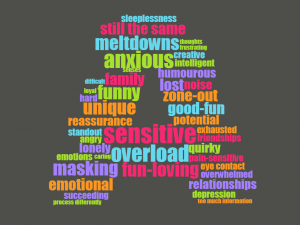 Currently there are about four autistic boys to every one girl with autism. However, with the increasing knowledge of the causes of autism and increased understanding of the broad range of characteristics within the spectrum, it is recognised that there is an under-diagnosis of autism in girls.
Currently there are about four autistic boys to every one girl with autism. However, with the increasing knowledge of the causes of autism and increased understanding of the broad range of characteristics within the spectrum, it is recognised that there is an under-diagnosis of autism in girls.
Girls are either being mis-diagnosed, or their autism is being missed altogether. The diagnostic tools used in the past are based on the male traits of autism and they don’t pick up the presentation of autism in girls. In addition, girls tend to mask their symptoms and therefore their difficulties aren’t so obvious.
In some cases the girl may be diagnosed with anxiety, low mood, an eating disorder or OCD. Self-harming behaviour is a commonly used coping strategy for undiagnosed autistic girls. However, having to cope in a “one-size-fits-all” world which is overwhelming, confusing and unpredictable will lead to high anxiety and low mood and a strong sense of not fitting in and feeling different.
How might autism present in girls and women?
- Autistic females can find it difficult to maintain eye contact, read facial expressions, socialise and keep up with the ebb and flow of conversation. Often, they will put on a mask, mimicking others and ‘shape-shifting’ their personality to fit those around them. Whilst doing this, there is the constant worry about whether they are getting it right, have they said the right thing, have they responded in the right way to a friend?
- Many girls will also experience higher or lower levels of sensitivity to one of the senses, such as sound, touch or taste. A girl may find certain noises so loud that it hurts and becomes overwhelming. Too much touch can result in sensory overload.
- Transitions and change can be difficult to cope with. It is common for girls to experience problems, and for the symptoms of autism to emerge or be stronger following a transition from nursery to primary, from primary to secondary school and then on from school to college, work or uni.
- These factors can lead to too much information – an overload of sensory input, information, emotions and feelings, resulting in a meltdown – crying, screaming, breaking things, head-banging, getting aggressive, swearing a lot, biting etc. Often the meltdown may be followed by a shutdown, when the girl withdraws and may need silence and darkness to help her recover.
In a girl without a diagnosis of autism, these difficulties and meltdowns mean she can be seen as weird by her peers, finds coping at school/uni/college very difficult, and poses problems for her family in managing her challenging behaviour. A diagnosis of autism provides a framework for understanding the girl’s challenges, signposts a way forward in helping her cope, and helps her family understand and support her.
If you would like to talk more about your daughter’s autism diagnosis, get some one-to-one counselling and coaching support for her, or you are worried about your undiagnosed daughter, please contact westend counselling here.
There is lots more information at a fabulous website for autism and Aspergers
